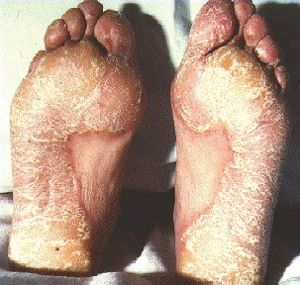Psoriasis
Definition
A scaly and inflammatory rash caused by hyperproliferation of keratinocytes.
Epidemiology
Affects both sexes pretty much equally and has a prevalence of around 2% in the UK population. There is a genetic element to the disease. It peaks at 15-20 and 55-60 and results in a seronegative arthropathy in about 7% patients.
Pathophysiology
The causes are multifactorial - genetic, infective in some cases (guttate), stress, trauma, drugs (alcohol, beta-blockers, NSAIDs, antimalarials, lithium).
The main mechanism is hyperproliferation of keratinocytes in response to cytokines. The time it takes for epidermal cells to move through the epidermis (transit time) changes from 30 days to about 2-3 days. The epidermis becomes 3-5 times thicker than usual (acanthosis); and starts to form "rete" ridges (arrowheads). This layer thickens further forming the stratum corneum".
There is more intracellular adhesion in the epidermis and it is infiltrated by neutrophils and lymphocytes. You can get (Munro's) microabscesses in the stratum corneum. Finally, you get dilated, tortuous capillaries in the outer dermal layer. When scales are removed it causes pin-point bleeding called Auspitz sign.
